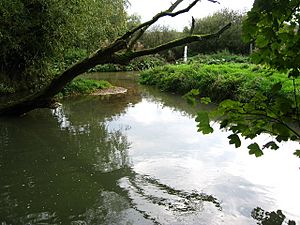River Eye, Leicestershire facts for kids
The River Eye is a small river in north-eastern Leicestershire, England. It flows for about 13 miles (21 km).
The River Eye starts near Bescaby, about 6 miles (10 km) north-east of Melton Mowbray. It flows east, then turns south past villages like Sproxton and Coston. At Saxby, it turns west, passing Stapleford and other villages.
The river then reaches Melton Mowbray, flowing under bridges. Near Sysonby, the River Eye changes its name to the River Wreake. The Wreake then flows into the larger River Soar.
Contents
About the River Eye
The River Eye is not very wide or fast-moving. It flows through the gentle countryside of north-east Leicestershire. The area has many fields with hawthorn hedges. There are not many natural forests here. Most woodlands are small, man-made areas called fox coverts.
Farming in this region mainly involves raising animals. Farmers keep sheep and cows in the grasslands. These animals are important for local agriculture. Famous cheeses like Stilton and Red Leicester originally came from farms in the River Eye area.
History of the River Eye
What's in a Name?
The name "Eye" comes from an old English word, ēa. This word simply means "the river." It is likely that the river had an even older name, but it has been lost over time.
The name "Wreake," which the river becomes, has a different origin. It comes from a Danish word. "Wreake" means "the twisting or meandering one," describing how the river winds and turns.
Ancient Times and Early People
The River Eye has been important to people for many centuries. North-east of the river, at Saltby Heath, you can find King Lud's Entrenchments. These are old earthworks that might be from prehistoric times. Historians are still studying them. These earthworks are near the border with Lincolnshire, which might have been an old boundary between different groups of people.
About 6 miles south of the river, near Melton Mowbray, are the remains of an Iron Age hill fort at Burrough Hill. This fort might have been the main center for the Corieltauvi people. They lived in the East Midlands, in areas like Leicester, Lincoln, Nottingham, and Rutland. It is thought that an old path went from Burrough Hill, crossed the River Eye, and continued north. Later, during Roman times, the main center for the Corieltauvi moved to Leicester. The Romans called it Ratis Corieltauvorum.
Danish and Saxon Villages Along the River
Many villages along the River Eye have names that come from Danish words. Other villages have Saxon names. This suggests that early settlers, both Danish and Saxon, used the river to reach their new homes. These villages were likely built on dry land close to the river, which provided a good water source.
For example, the village name "Stapleford" means "the ford (crossing) over the River Eye marked by posts." This shows that paths and crossings around the Eye were used over a thousand years ago.
Melton Mowbray became an important trading center in the River Eye area during Saxon times. Its market was probably active even before the Norman conquest in 1066. It is one of the few markets in England mentioned in the Domesday Book from 1085. Melton Mowbray has continued to be the main trading center in the area ever since.
Changes in the 1800s
In the early 1800s, the Oakham Canal was built. It used the Eye valley for part of its route. About 6 miles (10 km) of the river, from Stapleford to Sysonby, was made deeper and straighter to become part of the canal.
Later, in 1844, the Midland Railway built a railway line next to the canal. The railway company bought out the canal company. The railway then allowed the canal to fall apart because it was a competitor to their new train route. Today, only a few small parts of the old canal remain. The river has mostly returned to its natural state.
The River Eye Today
Today, the River Eye is a quiet part of the English countryside. Like many rivers, it has a long and interesting history, much of which is not written down. It is still very important as a source of water and helps drain the land.
The river is also used for fun activities. People enjoy fishing in its waters. Others like to walk along the public paths that cross its route. The River Eye even gave its name to the UK's first community radio station, "103 The Eye." This station has been broadcasting to Melton Mowbray and the Vale of Belvoir since 2005.


